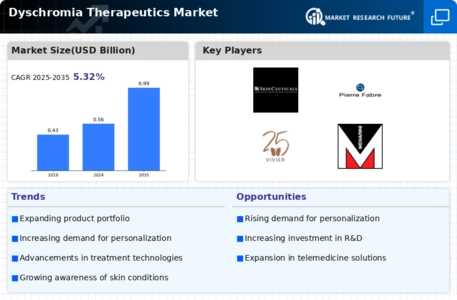Leading market players are investing heavily in research and development in order to expand their product lines, which will help the Dyschromia therapeutics market, grow even more. Market participants are also undertaking a variety of strategic activities to expand their global footprint, with important market developments including new product launches, contractual agreements, mergers and acquisitions, higher investments, and collaboration with other organizations. To expand and survive in a more competitive and rising market climate, Dyschromia therapeutics industry must offer cost-effective items.
Manufacturing locally to minimize operational costs is one of the key business tactics used by manufacturers in the global Dyschromia therapeutics industry to benefit clients and increase the market sector. In recent years, the Dyschromia therapeutics industry has offered some of the most significant advantages to medicine. Major players in the Dyschromia therapeutics market, including Bayer AG, ALLERGAN (AbbVie Inc.), Galderma S.A. (Nestle Skin Health S.A), SkinCeuticals, Pierre Fabre, EpiPharm AG, RXi Pharmaceuticals Corporation, Obagi Cosmeceuticals LLC (Obagi medical), Vivier Pharma, Sirona Biochem's, Menarini Group and others, are attempting to increase market demand by investing in research and development operations.
Allergan Ltd. (Allergan), a division of AbbVie Inc., is a specialty pharmaceutical business that develops and distributes branded, biosimilar, and over-the-counter (OTC) prescription drugs. It offers products in the areas of urology, gastrointestinal, central nervous system, ophthalmology, dermatology, and anti-infective treatments. The company offers its products to retailers, drug wholesalers, distributors, mail-order companies, medical facilities like hospitals and clinics, as well as to the government, managed healthcare providers like HMOs. It operates throughout the Americas, Europe, Asia-Pacific, Middle East, and Africa. Dublin, Ireland is home to Allergan's corporate headquarters.
Research, development, manufacture, and marketing of products for agricultural and human health are all activities carried out by Bayer AG (Bayer). It provides treatments for a variety of ailments, including those related to women's health, cardiovascular disease, hematology, and ophthalmology. Additionally, it seeks to develop cutting-edge technology and chemicals for application in contemporary agriculture and medical. Seeds, crop protection products, diagnostic imaging tools, specialist drugs, over-the-counter (OTC) goods, prescription goods, and non-agricultural pest management products make up the company's product portfolio. Bayer's healthcare and crop protection products are primarily distributed through wholesalers, pharmacies, hospitals, and retailers.
It operates through a network of subsidiaries across Asia-Pacific, Europe, North America, Latin America, Africa, and the Middle East. Bayer's headquarters are in Leverkusen, North Rhine-Westphalia, and Germany.
















Leave a Comment